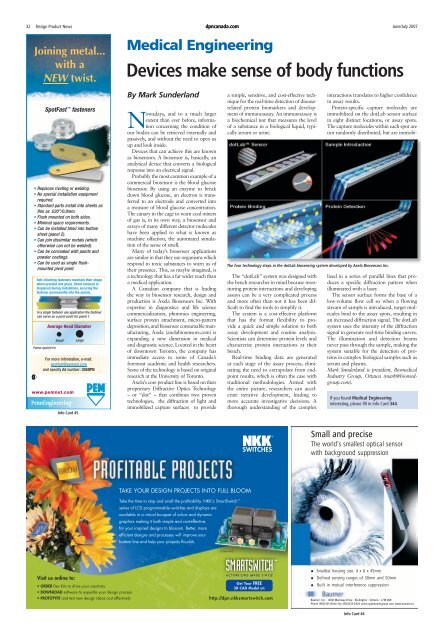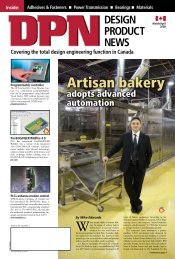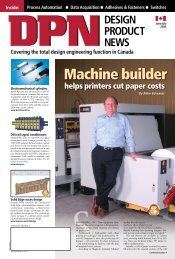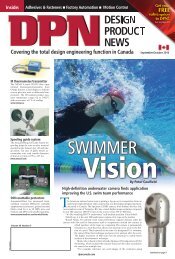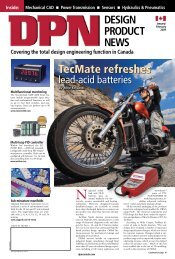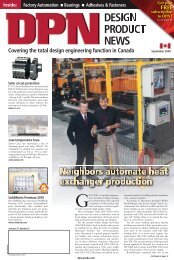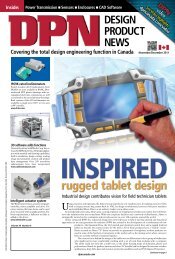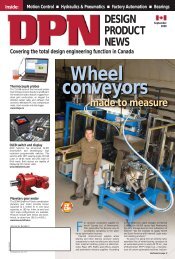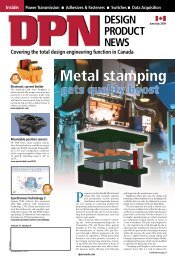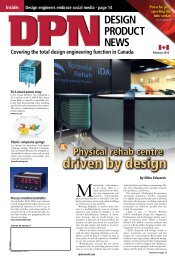DesIgn ProDuCT news - DPN Staff
DesIgn ProDuCT news - DPN Staff
DesIgn ProDuCT news - DPN Staff
Create successful ePaper yourself
Turn your PDF publications into a flip-book with our unique Google optimized e-Paper software.
32 Design Product News<br />
Joining metal...<br />
with a<br />
NEW twist.<br />
Medical Engineering<br />
dpncanada.com June/July 2007<br />
Devices make sense of body functions<br />
SpotFast fasteners<br />
• Replaces riveting or welding.<br />
• No special installation equipment<br />
required.<br />
• Standard parts install into sheets as<br />
thin as .030”/0.8mm.<br />
• Flush mounted on both sides.<br />
• Minimal space requirements.<br />
• Can be installed blind into bottom<br />
sheet (panel 2).<br />
• Can join dissimilar metals (which<br />
otherwise can not be welded).<br />
• Can be concealed with paints and<br />
powder coatings.<br />
• Can be used as single flushmounted<br />
pivot point.<br />
Self-clinching fasteners maintain their shape<br />
when pressed into place. Sheet material is<br />
displaced during installation, securing the<br />
fastener permanently into the panels.<br />
In a single fastener use application the fastener<br />
can serve as a pivot point for panel 1.<br />
Patent applied for.<br />
Average Head Diameter<br />
Small<br />
www.pemnet.com<br />
Info Card 45<br />
Large<br />
For more information, e-mail:<br />
spotfast@pemnet.com<br />
and specify Ad number: 305<strong>DPN</strong><br />
By Mark Sunderland<br />
Nowadays, and to a much larger<br />
extent than ever before, information<br />
concerning the condition of<br />
our bodies can be retrieved externally and<br />
passively, and without the need to open us<br />
up and look inside.<br />
Devices that can achieve this are known<br />
as biosensors. A biosensor is, basically, an<br />
analytical device that converts a biological<br />
response into an electrical signal.<br />
Probably the most common example of a<br />
commercial biosensor is the blood glucose<br />
biosensor. By using an enzyme to break<br />
down blood glucose, an electron is transferred<br />
to an electrode and converted into<br />
a measure of blood glucose concentration.<br />
The canary in the cage to warn coal miners<br />
of gas is, in its own way, a biosensor and<br />
arrays of many different detector molecules<br />
have been applied to what is known as<br />
machine olfaction, the automated simulation<br />
of the sense of smell.<br />
Many of today’s biosensor applications<br />
are similar in that they use organisms which<br />
respond to toxic substances to warn us of<br />
their presence. This, as maybe imagined, is<br />
a technology that has a far wider reach than<br />
a medical application.<br />
A Canadian company that is leading<br />
the way in biosensor research, design and<br />
production is Axela Biosensors Inc. With<br />
expertise in diagnostics and life science<br />
commercialization, photonics engineering,<br />
surface protein attachment, micro-pattern<br />
deposition, and biosensor consumable manufacturing,<br />
Axela (axelabiosensors.com) is<br />
expanding a new dimension in medical<br />
and diagnostic science. Located in the heart<br />
of downtown Toronto, the company has<br />
immediate access to some of Canada’s<br />
foremost academic and health researchers.<br />
Some of the technology is based on original<br />
research at the University of Toronto.<br />
Axela’s core product line is based on their<br />
proprietary Diffractive Optics Technology<br />
– or “dot” – that combines two proven<br />
technologies, the diffraction of light and<br />
immobilized capture surfaces to provide<br />
a simple, sensitive, and cost-effective technique<br />
for the real-time detection of diseaserelated<br />
protein biomarkers and development<br />
of immunoassay. An immunoassay is<br />
a biochemical test that measures the level<br />
of a substance in a biological liquid, typically<br />
serum or urine.<br />
The “dotLab” system was designed with<br />
the bench researcher in mind because monitoring<br />
protein interactions and developing<br />
assays can be a very complicated process<br />
and more often than not it has been difficult<br />
to find the tools to simplify it.<br />
The system is a cost-effective platform<br />
that has the format flexibility to provide<br />
a quick and simple solution to both<br />
assay development and routine analysis.<br />
Scientists can determine protein levels and<br />
characterize protein interactions at their<br />
bench.<br />
Real-time binding data are generated<br />
at each stage of the assay process, eliminating<br />
the need to extrapolate from endpoint<br />
results, which is often the case with<br />
traditional methodologies. Armed with<br />
the entire picture, researchers can accelerate<br />
iterative development, leading to<br />
more accurate investigative decisions. A<br />
thorough understanding of the complex<br />
The four technology steps in the dotLab biosensing system developed by Axela Biosensors Inc.<br />
interactions translates to higher confidence<br />
in assay results.<br />
Protein-specific capture molecules are<br />
immobilized on the dotLab sensor surface<br />
in eight distinct locations, or assay spots.<br />
The capture molecules within each spot are<br />
not randomly distributed, but are immobilized<br />
in a series of parallel lines that produces<br />
a specific diffraction pattern when<br />
illuminated with a laser.<br />
The sensor surface forms the base of a<br />
low-volume flow cell so when a flowing<br />
stream of sample is introduced, target molecules<br />
bind to the assay spots, resulting in<br />
an increased diffraction signal. The dotLab<br />
system uses the intensity of the diffraction<br />
signal to generate real-time binding curves.<br />
The illumination and detection beams<br />
never pass through the sample, making the<br />
system suitable for the detection of proteins<br />
in complex biological samples such as<br />
serum and plasma.<br />
Mark Sunderland is president, Biomedical<br />
Industry Group, Ottawa (mark@biomedgroup.com).<br />
If you found Medical Engineering<br />
interesting, please fill in Info Card 344.<br />
<br />
<br />
<br />
TAKE YOUR DESIGN PROJECTS INTO FULL BLOOM<br />
Take the time to stop and smell the profitability. NKK’s SmartSwitch <br />
series of LCD programmable switches and displays are<br />
available in a virtual bouquet of colors and dynamic<br />
graphics making it both simple and cost-effective,<br />
for your inspired designs to blossom. Better, more<br />
efficient designs and processes will improve your<br />
bottom line and help your projects flourish.<br />
IS Dev Kit-2<br />
Visit us online to:<br />
• ORDER Dev Kits to drive your creativity<br />
• DOWNLOAD software to expedite your design process<br />
• PROTOTYPE and test new design ideas cost effectively<br />
Get Your FREE<br />
3D CAD Model at:<br />
http://dpn.nkksmartswitch.com<br />
<br />
<br />
<br />
<br />
<br />
Info Card 46


